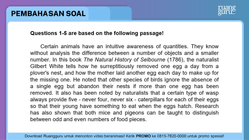Iklan
Pertanyaan
Questions 1-5 are based on the following passage!
Certain animals have an intuitive awareness of quantities. They know without analysis the difference between a number of objects and a smaller number. In this book The Natural History of Selbourne (1786), the naturalist Gilbert White tells how he surreptitiously removed one egg a day from a plover's nest, and how the mother laid another egg each day to make up for the missing one. He noted that other species of birds ignore the absence of a single egg but abandon their nests if more than one egg has been removed. It also has been noted by naturalists that a certain type of wasp always provide five - never four, never six - caterpillars for each of their eggs so that their young have something to eat when the eggs hatch. Research has also shown that both mice and pigeons can be taught to distinguish between odd and even numbers of food pieces.
These and similar accounts have led some people to infer that creatures other than human can actually count. They also point to dogs that have been taught to respond to numerical questions with the correct number of bark, or to horses that seem to solve arithmetic problems by stomping their hooves the proper number of times.
Animals respond to quantities only when they are connected to survival as a species - as in the case of eggs- or survival as individuals - as in the case of food. There is no transfer to other situations or from concrete reality to the abstract notion of numbers. Animals can 'count' only when the objects are present and when the numbers involved are small- no more than seven or eight. In lab experiments, animals trained to 'count' one kind of object were unable to count any other type. The objects, not the numbers, are what interest them. Animals' admittedly remarkable achievements simply do not amount to evidence of counting, nor do they reveal more than innate instincts, refined by the genes of successive generations, or the results of clever, careful conditioning by trainers.
3. According to information in the passage, which of the following is LEAST likely to occur as a result of animals' intuitive awareness of quantities?
3. According to information in the passage, which of the following is LEAST likely to occur as a result of animals' intuitive awareness of quantities?
A pigeon is more attracted by a box containing two pieces of food than by a box containing one piece.
When asked by its trainer how old it is, a monkey holds up five fingers.
When one of its four kittens crawls away, a mother cat misses it and searches for the missing kittens.
A certain type of wasp always provides five caterpillars for each of their eggs.
A lion follows one antelope instead of a herd of antelopes because it is easier to hunt a single prey.
Iklan
N. Puspita
Master Teacher
2
5.0 (1 rating)
Iklan
Pertanyaan serupa
RUANGGURU HQ
Jl. Dr. Saharjo No.161, Manggarai Selatan, Tebet, Kota Jakarta Selatan, Daerah Khusus Ibukota Jakarta 12860
Produk Ruangguru
Bantuan & Panduan
Hubungi Kami
©2025 Ruangguru. All Rights Reserved PT. Ruang Raya Indonesia

















